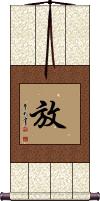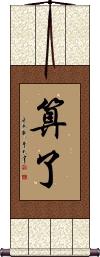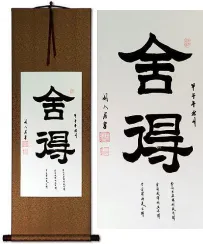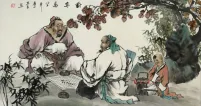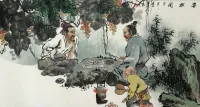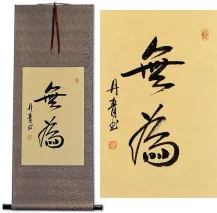Many custom options...
And formats...

The name Let It Go in Chinese / Japanese...
Buy a Let It Go calligraphy wall scroll here!
Personalize your custom “Let It Go” project by clicking the button next to your favorite “Let It Go” title below...
Release / Let Go
放 means to release, to free, to let go, to let out, to set off (fireworks).
In Japanese, this can also be a place called Hanashi
放 is also used in the context of Buddhism.
In Buddhism, this can represent the release of desire, materialism, suffering, or mortality.
Let It Be
Let It Be / Be Relieved
眉を開く is a Japanese proverb and expression that means “to feel relieved,” “to forget about one's troubles,” or “to settle into peace of mind.”
The literal words suggest relaxing your eyebrows or face. Allow worry or concern to go away, and just be content with “letting it be.”
Note: Because this selection contains some special Japanese Hiragana characters, it should be written by a Japanese calligrapher.
Forgive and Forget
略跡原情 is a Chinese proverb that means “to overlook past faults,” or “forgive and forget.”
It's more literally, “Abridge or make small the scars from your past emotions.” You should let it go.
The character breakdown:
略 (lüè) abbreviation; omission; abridge.
跡 (jī) ruins; scar; traces.
原 (yuán) former.
情 (qíng) feeling; emotion.
This in-stock artwork might be what you are looking for, and ships right away...
Gallery Price: $200.00
Your Price: $69.88
Gallery Price: $79.00
Your Price: $43.88
Not the results for let it go that you were looking for?
Below are some entries from our dictionary that may match your let it go search...
| Characters If shown, 2nd row is Simp. Chinese |
Pronunciation Romanization |
Simple Dictionary Definition |
拉倒 see styles |
lā dǎo la1 dao3 la tao |
(coll.) forget it; drop it; let it go; to pull down |
善罷甘休 善罢甘休 see styles |
shàn bà gān xiū shan4 ba4 gan1 xiu1 shan pa kan hsiu |
(idiom) to let the matter rest; to just let it go; to take it lying down (usu. used in the negative) |
放 see styles |
fàng fang4 fang hanashi はなし |
More info & calligraphy: Release / Let Go(place-name) Hanashi To let go, release, send out; put, place. |
下 see styles |
xià xia4 hsia shimo しも |
down; downwards; below; lower; later; next (week etc); second (of two parts); to decline; to go down; to arrive at (a decision, conclusion etc); measure word to show the frequency of an action (1) (ant: 上・かみ・1) lower reaches (of a river); (2) bottom; lower part; (3) lower half (of the body, esp. the privates); feces (faeces); urine; menses; (4) end; far from the imperial palace (i.e. far from Kyoto, esp. of western Japan); (can be adjective with の) (5) dirty (e.g. dirty jokes, etc.); (place-name, surname) Shimo hīna, adhara. Below, lower, inferior, low; to descend, let down, put down. |
燒 烧 see styles |
shāo shao1 shao shō |
to burn; to cook; to stew; to bake; to roast; to heat; to boil (tea, water etc); fever; to run a temperature; (coll.) to let things go to one's head To burn. |
脫 脱 see styles |
tuō tuo1 t`o to datsu |
to shed; to take off; to escape; to get away from To take the flesh from the bones; to strip, undress, doff; to escape, avoid; let go, relinquish. |
舍 see styles |
shè she4 she sha |
(bound form) residence; house; (bound form) my (in speaking of relatives younger than oneself, as in 舍妹[she4mei4]); (archaic) unit of distance equal to 30 li 里[li3] A shelter, cottage; used as a term of humility for "my"; to lodge; let go, relinquish. |
解 see styles |
xiè xie4 hsieh kai かい |
acrobatic display (esp. on horseback) (old); variant of 懈[xie4] and 邂[xie4] (old) (1) {math} solution (of an equation, inequality, etc.); root (e.g. of a polynomial); (2) solution (to a given problem); answer; (3) explanation; interpretation; (surname) Shie To unloose, let go, release, untie, disentangle, explain, expound; intp. by mokṣa, mukti, vimokṣa, vimukti, cf. 解脫. |
語 语 see styles |
yù yu4 yü go ご |
(literary) to tell; to let (sb) know (n,n-suf,ctr) (1) word; term; (n,n-suf) (2) language; (3) speech; (given name) Kataru Words, discourse, conversation, speech, language; to say, speak with; cf. 嚕 ruta. |
さあ see styles |
saa / sa さあ |
(conj,int) (1) come; come now; come along; go on; hurry up; (2) well; who knows; I don't know...; uh; hmm; (3) (said when surprised or happy) well now; let's see; there we go; all right; (4) about that; you see |
下す see styles |
kudasu くだす orosu おろす |
(transitive verb) (1) to make a decision; to draw a conclusion; (2) to judge; to hand down a verdict; to pass sentence; (3) to let go down; to lower; (4) to do oneself; to do by oneself; (5) to beat; to defeat; (6) to have loose bowels; to have diarrhea; to pass excrement; (irregular okurigana usage) (transitive verb) (1) to take down (e.g. flag); to launch (e.g. boat); to drop; to lower (e.g. ladder); to let (a person) off; to unload; to discharge; (2) to drop off (a passenger from a vehicle); to let (a person) off; (3) to withdraw money from an account; (4) to wear (clothing) for the first time; (5) to fillet (e.g. a fish) |
不依 see styles |
bù yī bu4 yi1 pu i fue |
not to comply; not to go along with; not to let off easily; not to let sb get away with it not relying |
不問 不问 see styles |
bù wèn bu4 wen4 pu wen fumon ふもん |
to pay no attention to; to disregard; to ignore; to let go unpunished; to let off (n,n-suf) (See 不問に付す) not asking (about); letting go unquestioned; disregarding; ignoring; overlooking |
不捨 不舍 see styles |
bù shě bu4 she3 pu she fusha |
reluctant to part with (something or sb); unwilling to let go of not rejecting |
任情 see styles |
rèn qíng ren4 qing2 jen ch`ing jen ching |
to let oneself go; to do as much as one pleases |
切る see styles |
kiru きる |
(transitive verb) (1) to cut; to cut through; to perform (surgery); (transitive verb) (2) (See 縁を切る) to sever (connections, ties); (transitive verb) (3) to turn off (e.g. the light); (transitive verb) (4) (See 電話を切る) to terminate (e.g. a conversation); to hang up (the phone); to disconnect; (transitive verb) (5) to punch (a ticket); to tear off (a stub); (transitive verb) (6) to open (something sealed); (transitive verb) (7) to start; (transitive verb) (8) to set (a limit); to do (something) in less or within a certain time; to issue (cheques, vouchers, etc.); (transitive verb) (9) (See 値切る) to reduce; to decrease; to discount; (transitive verb) (10) to shake off (water, etc.); to let drip-dry; to let drain; (transitive verb) (11) to cross; to traverse; (transitive verb) (12) to criticize sharply; (transitive verb) (13) to act decisively; to do (something noticeable); to go first; to make (certain facial expressions, in kabuki); (transitive verb) (14) (See ハンドルを切る) to turn (vehicle, steering wheel, etc.); (transitive verb) (15) to curl (a ball); to bend; to cut; (transitive verb) (16) to shuffle (cards); (transitive verb) (17) {mahj} to discard a tile; (transitive verb) (18) to dismiss; to sack; to let go; to expel; to excommunicate; (transitive verb) (19) to dig (a groove); to cut (a stencil, on a mimeograph); (transitive verb) (20) (See 切り札・1) to trump; (transitive verb) (21) {go} to cut (the connection between two groups); (transitive verb) (22) (also written as 鑽る) to start a fire (with wood-wood friction or by striking a metal against stone); (transitive verb) (23) to draw (a shape) in the air (with a sword, etc.); (suf,v5r) (24) (after the -masu stem of a verb) (See 使い切る) to do completely; to finish doing; (suf,v5r) (25) (after the -masu stem of a verb) (See 疲れ切る) to be completely ...; to be totally ...; to be terribly ...; (suf,v5r) (26) (after the -masu stem of a verb) (See 言い切る・1) to do clearly; to do decisively; to do firmly |
徹す see styles |
toosu とおす |
(transitive verb) (1) to stick through; to force through; (2) to spread throughout; to thoroughly diffuse; (3) to make a path between two points; (4) to proceed in a logical manner; (5) to let pass; to allow through; (6) to lead (someone) into (a house, room, etc.); to show in; (7) to go through (a middleman); (8) to (look, listen) through (a window, wall, etc.); (9) to pass (a law, applicant, etc.); (10) to force to accept; to force agreement; (11) to continue (in a state); to persist in; (12) to do to the entirety of; to cover all of; to span the whole ...; (13) to do from beginning to end without a break; (14) to convey (one's ideas, etc.) to the other party; (15) to do to the end; to carry through; to complete |
戀戀 恋恋 see styles |
liàn liàn lian4 lian4 lien lien |
reluctant (to leave, to let go etc) See: 恋恋 |
抜く see styles |
nuku ぬく |
(transitive verb) (1) to pull out; to draw out; to extract; to unplug; to weed; (transitive verb) (2) to omit; to leave out; to go without; to skip; (suf,v5k) (3) (after the -masu stem of a verb) to do to the end; to do thoroughly; to do completely; to do severely; (transitive verb) (4) to let out (e.g. air from a tyre); to drain (e.g. water from a bath); to empty; (transitive verb) (5) to pick out; to choose; to select; to extract; (transitive verb) (6) to pilfer; to steal; (transitive verb) (7) to remove; to get rid of; to take out; (transitive verb) (8) to pass; to overtake; to outstrip; to get ahead of; (transitive verb) (9) (also written 貫く) to pierce; to break through; to go through; (transitive verb) (10) to cut out (a shape); to create (a pattern) by dying the surrounding area; (transitive verb) (11) to seize; to capture; to reduce; (transitive verb) (12) to scoop (a story); (transitive verb) (13) to take out (an opponent's stones; in go); (Godan verb with "ku" ending) (14) (slang) (vulgar) to masturbate (of a male); to ejaculate (while masturbating); (Godan verb with "ku" ending) (15) (slang) to take (a photo); to record (video) |
撒手 see styles |
sā shǒu sa1 shou3 sa shou |
to let go of something; to give up |
擺爛 摆烂 see styles |
bǎi làn bai3 lan4 pai lan |
(neologism c. 2014) (slang) to stop striving (esp. when one knows one cannot succeed); to let it all go to hell; (sports) to tank |
攤手 摊手 see styles |
tān shǒu tan1 shou3 t`an shou tan shou |
to throw up one's hands; to loosen one's grip; to let go |
放す see styles |
hanasu はなす |
(transitive verb) (1) to release; to let go; to free; to set free; to let loose; to turn loose; (transitive verb) (2) to add (pieces of eggplant, potato, etc.) to water, broth, etc. |
放下 see styles |
fàng xià fang4 xia4 fang hsia houka; houge / hoka; hoge ほうか; ほうげ |
to lay down; to put down; to let go of; to relinquish; to set aside; to lower (the blinds etc) (noun/participle) (1) (archaism) {Buddh} discarding; abandoning; (noun/participle) (2) (ほうか only) variety of street performance from the Middle Ages; (noun/participle) (3) (ほうげ only) casting off one's attachments (in Zen) To put down, let down, lay down. |
放手 see styles |
fàng shǒu fang4 shou3 fang shou |
to let go one's hold; to give up; to have a free hand |
放開 放开 see styles |
fàng kāi fang4 kai1 fang k`ai fang kai |
to let go; to release |
株守 see styles |
zhū shǒu zhu1 shou3 chu shou |
to stick to something stubbornly; never let go |
流す see styles |
nagasu ながす |
(transitive verb) (1) to drain; to pour; to run; to let flow; to flush; to shed (blood, tears); to spill; (transitive verb) (2) to float (e.g. logs down a river); to set adrift; (transitive verb) (3) to wash away; to carry away; to sweep away; (transitive verb) (4) to broadcast; to play (e.g. music over a loudspeaker); to send (electricity through a wire); (transitive verb) (5) to circulate (a rumour, information, etc.); to spread; to distribute; (v5s,vi) (6) to cruise (of a taxi); to stroll around (in search of customers, an audience, etc.); to go from place to place; (transitive verb) (7) to cancel (a plan, meeting, etc.); to call off; to reject (e.g. a bill); (transitive verb) (8) to forfeit (a pawn); (v5s,vi) (9) to do leisurely (e.g. running, swimming); to do with ease; to do effortlessly; (transitive verb) (10) to exile; to banish; (transitive verb) (11) {baseb} to hit (the ball) to the opposite field; (suf,v5s) (12) (after the -masu stem of a verb) to do inattentively; to do without concentrating; to put little effort into doing; (transitive verb) (13) to cause a miscarriage; to abort |
留下 see styles |
liú xià liu2 xia4 liu hsia |
to leave behind; to stay behind; to remain; to keep; not to let (sb) go |
緊握 紧握 see styles |
jǐn wò jin3 wo4 chin wo |
to hold firmly, not let go |
Click here for more let it go results from our dictionary
The following table may be helpful for those studying Chinese or Japanese...
| Title | Characters | Romaji (Romanized Japanese) | Various forms of Romanized Chinese | |
| Release Let Go | 放 | hana / pang | fàng / fang4 / fang | |
| Let It Be | 算了 | suàn le / suan4 le5 / suan le / suanle | ||
| Let It Be Be Relieved | 眉を開く | mayu o hira ku mayuohiraku | ||
| Forgive and Forget | 略跡原情 略迹原情 | lüè jì yuán qíng lve4 ji4 yuan2 qing2 lve ji yuan qing lvejiyuanqing | chi yüan ch`ing chiyüanching chi yüan ching |
|
| In some entries above you will see that characters have different versions above and below a line. In these cases, the characters above the line are Traditional Chinese, while the ones below are Simplified Chinese. | ||||
Successful Chinese Character and Japanese Kanji calligraphy searches within the last few hours...
